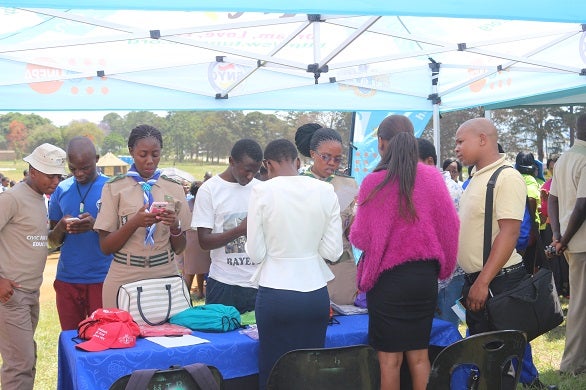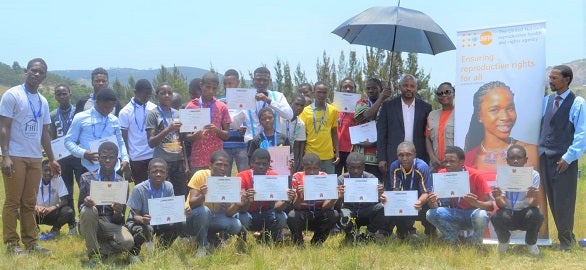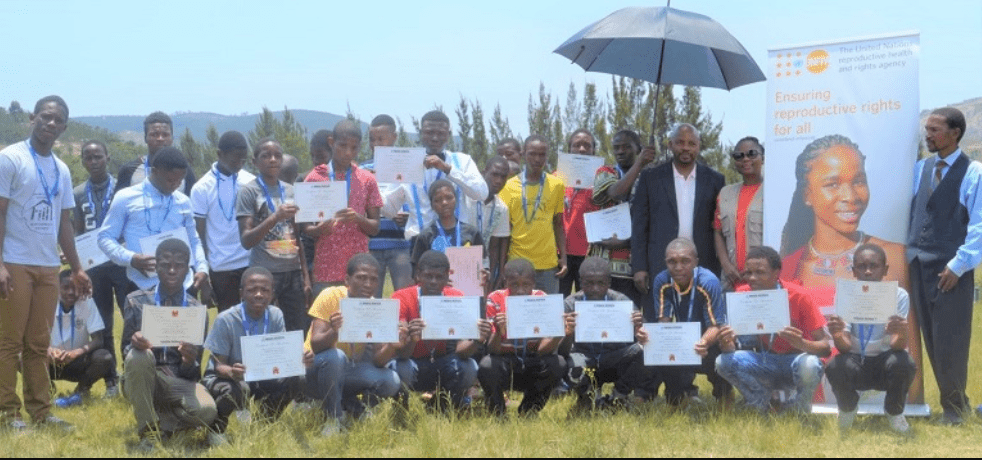
Condomize stall at the MTN Bushfire festival ©UNFPA2018
The CONDOMIZE! campaign launched in Eswatini in 2014 continues to reach greater heights year after year. It has become a regular feature in major social events such as the MTN Bushfire festival, which commands an audience of mostly young people in excess of 20,000. In 2018, the campaign distributed a record high of 308,985 male condoms and 8,405 female condoms with a reach of about 20, 000 patrons. When asked about usefulness of the CONDOMIZE! Stall at the Bushfire event, one young person, a male aged 23 had this to say; “The CONDOMIZE! Stall is one of my favorite spots at the Bushfire event because I get to re-fill my condom stock and a chance to refresh my knowledge on how to get the most out of condoms. Ever since I started visiting this stall which is about 3 years ago, sex with a condom has gotten better and I cannot even imagine indulging without a condom”.

Women accessing female condoms during the Buhle Bami Style and Beauty Expo©UNFPA2018
Emaswati women are slowly warming up to the female condom and in one beauty expo, 2000 female condoms
were distributed among 300 women of reproductive age. A woman aged 34 interviewed at the expo said that the
“female condom gives her more bargaining power over her partner because it puts her in a good position to negotiate for safer sex”.

Young people accessing integrated SRHR information through Tune Me mobisite during one of the
promotional events©UNFPA2018
The CO has also made great strides in terms of disseminating Sexual and Reproductive Health and Rights, HIV and Gender Based Violence information especially to young people. Through the tune me mobisite which has since been upgraded into an application, UNFPA Eswatini has reached more than 83,845 young people and more than 37 557 are registered active users of the site since its launch in July 2017.

Young men graduating from the young men and boys as agents of change intervention©UNFPA2018
The Country Office broke new ground through its programme on engaging men and boys as agents of change. A total of 379 boys from two communities namely Mahwalala and Siphocosini were reached with an integrated service package comprising SRH, GBV and HIV.
On the advocacy front, the CO contributed to improved understanding on the Demographic Dividend among leaders of institutions in both Government and Civil Society. According to the National Demographic Dividend Study, the window of opportunity has opened up for Eswatini and the time is right to sensitize all concerned parties to take full advantage of this once in a lifetime opportunity. The idea is to create a critical mass of Demographic Dividend advocates in all sectors to push for increased investments among young people, who, evidence has shown, have the potential to turn the economy around and advance Eswatini to realize His Majesty’s vision for 2022 and the 2030 agenda on the SDGs. The 2017 census results show that the working age population, which is the engine for harnessing the DD, is continuing to grow.
With regards to capacity building, the Central Statistical Office, with technical backing from the Country Office, achieved remarkable progress by launching the second annual Civil Registration and Vital Statistics Report (CRVS). The report shows that the CRVS system is far from reaching completeness as birth registration is just under 15 percent. The annual report therefore, is currently being used an advocacy tool to improve the CRVS system. The greatest value of a well-functioning CRVS system is that it is by far, the only source, that has the potential to provide data on population dynamics on a continuous basis and at the lowest geographical level. This feature of the CVRS enables disaggregation of data as far low as possible and therefore can be used to map out, on a continuous basis, populations that are being left behind.


